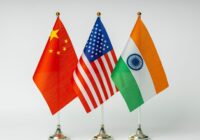The Trump administration’s trade advisors argue that greater dependence on bilateral trade agreements will provide maximum advantages for US exporters and consumers.
In the short span of weeks, the Trump administration has discarded the moribund Trans-Pacific Partnership and the American-European Transatlantic Trade and Investment Partnership (TTIP), and has announced plans to renegotiate the terms of the North American Free Trade Agreement (NAFTA) with Canada and Mexico. The new administration’s trade advisors, led by economist Peter Navarro, argue that greater dependence on bilateral — rather than multilateral — trade agreements will enable US negotiators to craft provisions that provide maximum advantages for US exporters and consumers. What are the arguments in favor of, and against, such an approach?
Bilateral trade agreements do come with some problems, says Gary Clyde Hufbauer, senior fellow at the Peterson Institute for International Economics. “First, bilateral agreements take a fair amount of time, and probably more time [in this case] since the Trump administration’s demands are significantly higher than [in] prior free-trade agreements. They want the other countries to give and give until they’ve given everything — and more demands mean more negotiating time. In addition, each new bilateral [agreement] is going to have to be ratified by the US Congress. You’re using a very valuable commodity — which is congressional time for the ratification process. They take time, and you have to massage the Congress.”
Still, multilateral agreements “have become unwieldy and large,” notes Wharton Management Professor Mauro Guillen, and so bilateral plans can be viewed as more manageable for negotiators and companies that rely on them to gain market access. “But bilateral deals risk treating some countries better than others. The US already does this with its FTAs [free-trade agreements] with Colombia, Israel, South Korea and many other countries in addition to Mexico and Canada. The issue [becomes whether] those bilateral agreements will be about free trade or about privileging some countries over others.”
In a similar vein, Hufbauer argues that bilateral agreements also have a second major disadvantage: “The various [bilateral] agreements might [have provisions that are] slightly different [from one another] on, say, digital commerce, or on state-owned enterprises or whatever. And so, you end up with a more confusing array of agreements that firms must deal with” with regard to individual countries.
For example, he notes that the US already has a series of bilateral treaties that are not well-known: the bilateral tax treaties. “The US has about 60 of them. In those negotiations, each negotiating partner looks at the previous treaty and then wants the best treatment of all the previous treaties. That’s their demand going in, and if you don’t give it to them, they say, ‘Why don’t you love me as much as you love the previous [country]?’ … So the notion that you can squeeze one partner a lot harder than some other partner — well, maybe [you can,] but they’re all going to insist on equal treatment.”
On the other hand, Hufbauer adds, “the big advantage of bilateral pacts, from the Trump standpoint, is that the US, being the big boy on the block, will be able to extract more from its bilateral partners than its multilateral partners…. That’s the balance [Donald Trump is] playing.”
NAFTA is Safe… For Now
By late April, however, President Trump’s opposition to multilateral trade pacts no longer seemed to include a complete rejection — and destruction — of NAFTA. Rather, all signs point to a targeted re-negotiation of those clauses of NAFTA that are most troublesome to the Trump administration. According to an administration draft proposal being circulated in Congress by the US Trade Representative’s office, the US would keep some of NAFTA’s most controversial provisions, including an arbitration panel that lets investors in the three nations circumvent local courts to resolve civil claims. Critics of these panels said they impinge on national sovereignty.
It also seems likely that the US would also seek to renegotiate the US-Korea free-trade agreement enacted in 2012 (KORUS) through a similar process. Recently in Seoul, Vice President Mike Pence told a group of business leaders that the trade relationship between the US and South Korea needed to change, because US businesses “face too many barriers to entry, which tilts the playing field against American workers,” according to the Financial Times.
Regarding NAFTA, Hufbauer predicts that the congressional committees will grill US trade officials about “what they are expecting to get from Mexico and Canada from the renegotiation of NAFTA” within the next few months. “And then renegotiation will start. My guess is that once they start that process, within 30 or 60 days, they’ll get going on Korea next.”
Hufbauer notes that the hands of US trade negotiators “are going to be full” renegotiating the terms of US trade with Mexico and Canada. And while some predict that future bilateral deals might be struck with Japan and particularly the United Kingdom, “that’s not going to happen any time soon,” he says. In both cases, the negotiation process would also be fraught with challenges. Hufbauer points out that in the case of the UK, “We won’t really know what we’d be getting until they finish up their exit from the EU [European Union]. That’s at least two years [into the future], and could be longer. That’s well into the Trump administration. On Japan, the problem is that [Prime Minister Shinzo] Abe is very cautious … about having a free trade agreement with the United States alone, because he knows where the US is coming from. The US will want Japan to open agriculture much, much more than it did in the TPP. The Japanese felt that they gave as much as they could in the TPP, given their farm constituency.”
The Demise of the TPP
Supporters of the Trans-Pacific Partnership had argued that one of the 12-nation trade agreement’s greatest virtues was that it opened Japanese markets to US exports, in ways that Japan was willing to tolerate only because the TPP also promised to improve market access for Japanese exporters in other members of the TPP in Asia and Latin America. Is it feasible to negotiate a bilateral pact with Japan that delivers the same — or better — value for the US as the TPP would have delivered? “That’s the issue,” says Guillen. “Do these [bilateral] deals open up markets? It seems that the approach is too ad-hoc, case by case, and not holistic.”
 The Asia Pacific “is an important market for our companies,” says Rob Mulligan, senior vice president for policy and government affairs at the United States Council for International Business. “Our hope is that [the US] will pursue some other approach that will continue to open those markets and ensure that US companies are able to compete and have access in those markets. The multilateral approach, we generally felt, had advantages [in] that you could get many countries at one time… [A] lot of US businesses benefit from the global rules-based trade system.”
The Asia Pacific “is an important market for our companies,” says Rob Mulligan, senior vice president for policy and government affairs at the United States Council for International Business. “Our hope is that [the US] will pursue some other approach that will continue to open those markets and ensure that US companies are able to compete and have access in those markets. The multilateral approach, we generally felt, had advantages [in] that you could get many countries at one time… [A] lot of US businesses benefit from the global rules-based trade system.”
Hufbauer argues that there is “no doubt” that the US “would have been better off within the Trans-Pacific Partnership” than it will be in the event of a bilateral agreement with Japan. “Trump is completely wrong that the TPP would have been a disaster, and I think he is completely wrong in thinking he’ll get a better deal with this bilateral approach — but he is going to ask for a lot more. He may get some countries to sign on to his ‘ask’ — but we will see how far he gets.”
Hufbauer predicts that eventually, the other eleven signatories to the TPP may well ratify the TPP amongst themselves. “It may not happen for several months or later this year. The US will be out of the party, but the US will be welcome to come in when it wants.” What could happen then: “In 2019 -2020, maybe the US does negotiate a bilateral [deal] with Japan, which is basically the TPP provisions [regarding] Japan — maybe with a little enrichment in terms of Japanese opening [of its domestic markets and a little more of their agriculture markets]. And then, letting other countries dock onto that bilateral. I know that sounds [crazy], but it gets away from the administration having to say that they hated the TPP in 2016, and they love it in 2019. Cosmetically and structurally, this would be somewhat different.”
*[This article was originally published by Knowledge@Wharton, a partner institution of Fair Observer.]
The views expressed in this article are the author’s own and do not necessarily reflect Fair Observer’s editorial policy.
Photo Credit: michal812
Support Fair Observer
We rely on your support for our independence, diversity and quality.
For more than 10 years, Fair Observer has been free, fair and independent. No billionaire owns us, no advertisers control us. We are a reader-supported nonprofit. Unlike many other publications, we keep our content free for readers regardless of where they live or whether they can afford to pay. We have no paywalls and no ads.
In the post-truth era of fake news, echo chambers and filter bubbles, we publish a plurality of perspectives from around the world. Anyone can publish with us, but everyone goes through a rigorous editorial process. So, you get fact-checked, well-reasoned content instead of noise.
We publish 2,500+ voices from 90+ countries. We also conduct education and training programs
on subjects ranging from digital media and journalism to writing and critical thinking. This
doesn’t come cheap. Servers, editors, trainers and web developers cost
money.
Please consider supporting us on a regular basis as a recurring donor or a
sustaining member.
Will you support FO’s journalism?
We rely on your support for our independence, diversity and quality.






